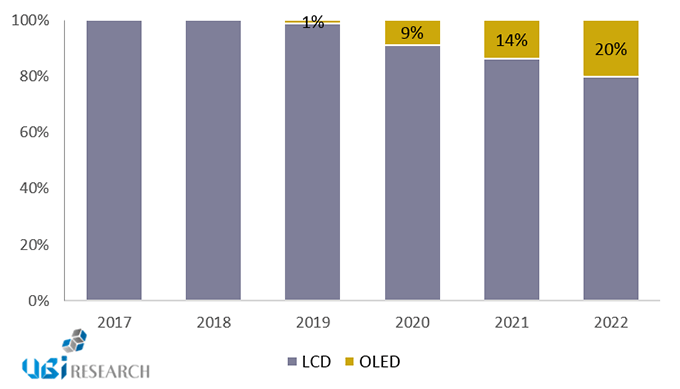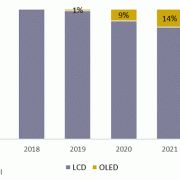OLED panel for automotive display to be applied from 2018/The core issue is for its life-time extension.
OLED panels are expected to be used in automotive displays joining to mobile devices and TVs.
It clearly revealed that the flexible OLEDs are becoming the flagship product for automotive display in CES2017 through the Chrysler’s conference as pre-event. (website: https://www.olednet.com/en/ces2017-media-day-chrysler-potal/)
According to the “Automotive Display Report – Application & Market Trend Analysis and the Market Forecast” published by Ubi Research, OLED panels are expected to be applied to automotive cluster and CID in earnest from 2018. It will be applied to premium cars first under flexibility and superiority of image quality.
Car manufacturers are attempting to differentiate themselves with the concepts of environmentally friendly, connected, smart, and autonomous driving, and thus the interface inside the vehicle is also changing. There might be a limit to the existing analogue methods since various information must be transmitted and processed especially, as developed connected, smart car, and autonomous vehicle.
Therefore, the role of display in automobiles is becoming increasingly important and the area of display is gradually widening. Especially, since the cluster and CID have many curved surfaces, it is difficult to apply a square display to a large area and accordingly, the importance of a flexible display is emphasized.
The automobile manufacturers show great interest to the AMOLED panel since it can provide high visibility to the drivers and it is flexible and applicable to any part of the automobile based on its fast response speed, wide viewing angle, high color reproduction rate and contrast range. It is under joint development with major panel makers.
However, there is a problem that the lifetime of the AMOLED panel is still insufficient for application to automobiles. According to the analyzing report, the lifetime of the AMOLED panel has met about 50% as compared to the requirements for the car display. The most important issue is securing lifetime for the AMOLED panel usage.
According to the report also, the automotive display market will grow at an annual average of about 17%, reaching US $ 25,000 million by 2022, and it forecasted that the AMOLED panel market will account for about 20%.

<Automotive display market share forecasting in 2017-2022>

